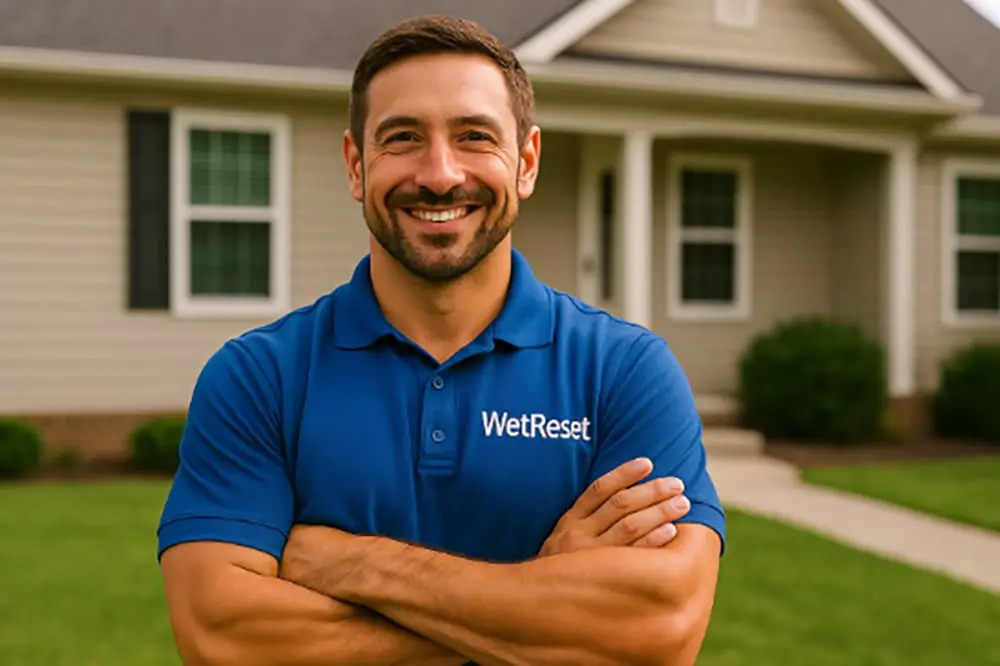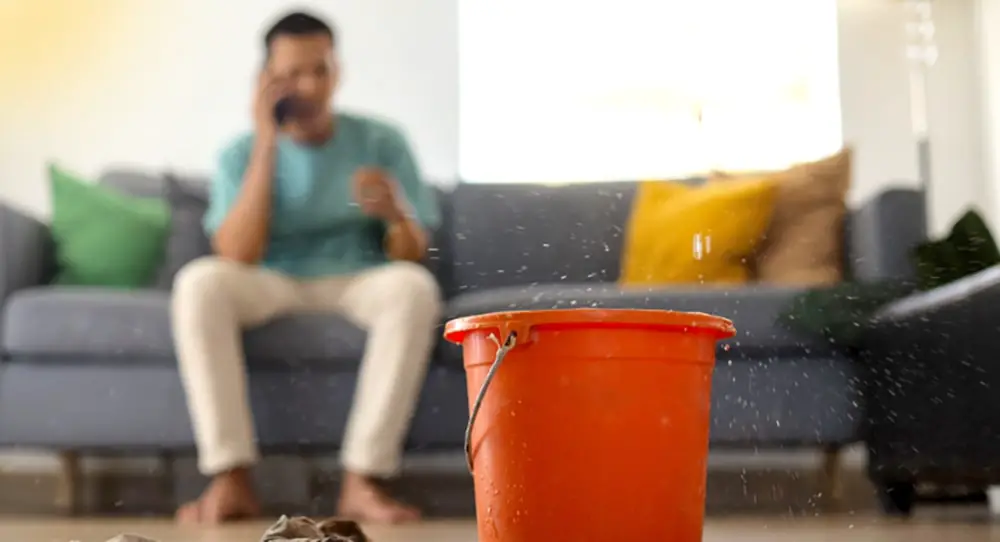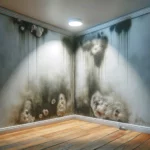That sound of dripping water when everything should be quiet. The damp spot spreading across your ceiling. The water bill that inexplicably doubled. If these occurrences seem familiar, you are certainly not alone – they are all signs of common water leaks in the home, and they happen surprisingly often.
Over the years, we have seen a huge number of water damage cases caused by hidden water pipe leaks. Knowing where they occur can help you spot trouble early, potentially saving thousands in repair costs and preventing the headache of major water damage.
So where is the most common water leak in a house, and what can you do about it, exactly? In this article, we are going to explain. Let’s get to it.
Most Common Places for Water Leaks in a House
While your plumbing system runs throughout your entire home, certain areas are more vulnerable to leaks due to factors like usage patterns, pipe connections, and even environmental conditions.
Here is where to look for the most common water leaks in the house:
Under Sinks and Cabinets
Kitchen and bathroom sink cabinets are among the top spots for household leaks. These hazard-prone areas contain multiple pipe connections, supply lines, and drain assemblies, each of which is a potential failure point.
The typical under-sink leak develops gradually from corroded P-traps, loose supply line connections, or (more commonly) worn-out sink seals. What makes these leaks particularly problematic is that they can go unnoticed for weeks or even months. You simply don’t know about the issue until it is too late.
To check for these ‘sneaky’ leaks, get into the habit of removing everything from under your sinks monthly and examine the area with a flashlight. Feel around for general dampness on the cabinet bottom and around pipe connections.
Look for water stains, warped wood, or mold – they are all strong indicators of a current or past water leak.
Toilets and Bathroom Plumbing
Bathroom plumbing is another hotspot for common water leaks in home settings. Toilets, in particular, contain multiple mechanisms that can fail, burst, and leak without glaringly obvious signs.
The most frequent toilet leaks occur from worn-out flappers that don’t seal properly, faulty fill valves that never completely shut off, cracked overflow tubes, or even failed wax rings that sometimes leak around the toilet base.
These leaks might seem like a mere waste of water, but they can be far more damaging, affecting the subfloor and causing serious structural issues if left unaddressed.
Behind Walls and Ceilings
Perhaps the most concerning type of water leak is when the plumbing inside walls break, causing potentially extensive damage before being discovered. These hidden leaks are a result of faulty supply pipes that run within wall cavities.
Warning signs of behind-wall leaks include water stains on walls or ceilings, bubbling paint or wallpaper, and warped or buckling drywall. Musty odors that persist (despite cleaning) are another common sign, along with unexplained mold spots, particularly near baseboards.
These water leaks often develop at pipe joints, where water pressure fluctuations and metal fatigue cause small failures over time. Homes with older plumbing systems – particularly those with galvanized pipes that corrode from the inside out – face even higher risks.
Detecting these hidden leaks early requires a great deal of vigilance. Pay extra attention to any discoloration on walls or ceilings, especially in areas beneath bathrooms or along known pipe routes.
Water Heaters and Boiler Systems
Water heaters are another major source of home water leaks, as they contain large volumes of water under constant pressure and temperature stress. As a result, they are prone to developing leaks over time.
Common water heater leak points include the temperature and pressure relief valve connection, input and output water line connections, the drain valve, or the tank itself, which can corrode from the inside out, once again not revealing the issue until it is too late.
Washing Machines, Refrigerators, and Dishwasher Hoses
Surprisingly, appliance connections cause a large percentage of common water leaks in home settings. Even modern machines that have been professionally fitted are prone.
Washing machines and dishwashers are the most common culprits, as they contain high-pressure water connections that undergo stress with each use cycle.
Even something as simple as a refrigerator can cause issues, though rarely, as the water line can loosen, crack, or disconnect entirely, leading to a fridge water line leak that may go unnoticed for days or weeks.
To check for these leaks, pull appliances away from walls once in a while to inspect behind and underneath them. Feel hoses for brittleness, bulging, or cracking, and look for telling mineral deposits or rust around connections.
💧WetReset Pro Tip💧
Replacing standard rubber hoses with braided stainless steel versions greatly reduces leak risks. For washing machines and dishwashers, installing water detection sensors provides early warning of developing leaks!
Basement and Crawl Spaces
Basements and crawl spaces frequently harbor hidden leaks owing to their limited visibility and high pipe concentration – not to mention the fact that most people rarely venture into the basement with the express purpose of inspecting for water leaks.
Higher humidity is a contributing factor to one of the most common water leaks in basements, as it accelerates pipe deterioration. Temperature fluctuations cause expansion and contraction that stresses connections. This can damage foundation elements and create the perfect breeding ground for mold growth.
Outdoor Faucets and Irrigation Systems
Outdoor plumbing is a frequently overlooked area, but it is actually one of the most common water leaks on a property. Exterior faucets and underground irrigation systems can develop major leaks that go undetected for weeks, months, or even years because they don’t directly impact living spaces.
Outdoor leaks often stem from freeze damage to exterior faucets, cracked irrigation system pipes or heads, worn valve seals, or underground pipe failures due to soil shifting or root intrusion.
These leaks often waste remarkable amounts of water while remaining hidden. A single cracked irrigation pipe can leak hundreds of gallons daily, most of which seeps harmlessly into the soil – until it eventually finds its way against your foundation.
How to Detect Plumbing Leaks in Your Home
Aside from knowing where to look for common water leaks in the home, you also need to know how to identify leaks early. As is always the case with water leaks, fast action can prevent minor issues from becoming major problems.
Signs of a Hidden Leak
Several indicators suggest a leak somewhere in your home’s plumbing:
- Water bills that suddenly increase without explanation
- The sound of running water when all fixtures are off
- Decreased water pressure at faucets or showers
- Warm spots on floors (for hot water pipe leaks)
- Unusually damp air or increased indoor humidity
Ultimately, your water meter provides one of the most reliable leak detection methods. To that end, with all water-using appliances and fixtures turned off, check your meter occasionally. If it continues to register movement, you probably have a leak somewhere in your system.

DIY Leak Detection Tips
Simple home tests can help locate most (but certainly not all) common water leaks in house plumbing. For faucets, place a dry paper towel around the base and check for dampness after running water for a minute.
To check for slab leaks at home (pipes running beneath concrete foundations), listen for the sound of running water when everything is quiet and turned off. Warm spots on floors can indicate hot water line leaks beneath.
For suspected plumbing leaks in walls, a moisture meter can help confirm dampness without cutting into drywall. These relatively inexpensive devices are available at most hardware stores and can detect moisture invisible to the naked eye.
When to Call a Plumber
While many leaks can be identified through DIY methods, certain situations call for professional assistance:
- When you suspect a leak but can’t locate its source
- If the leak appears to be inside a wall, ceiling, or under a concrete slab
- When you notice water damage but no visible leak
- If you hear running water sounds but all fixtures are off
Professional plumbers have specialized equipment, including electronic leak detectors, video pipe inspection cameras, and thermal imaging tools that can locate the most common water leaks in a house without extensive demolition.
Preventing Plumbing Leaks in Your Home
Prevention is always better than cure and is the single best approach to household plumbing leaks. Regular maintenance and forward-thinking, proactive measures can massively reduce your risk:
- Inspect visible plumbing connections monthly for signs of corrosion or moisture
- Replace washing machine hoses every 3-5 years, even if they appear fine
- Install water leak detection devices near high-risk areas like water heaters and under sinks
- Maintain proper water pressure (excessive pressure stresses pipes and connections)
- Winterize outdoor plumbing before freezing weather arrives
For older homes with aging plumbing, professional water damage inspection every few years can identify potential problem areas before they fail. While this does incur an upfront cost, it’s minimal compared to the expense of major water damage repairs in the long run.

Taking Action Against Water Leaks
Knowing where the most common water leaks in a home can happen is important for all homeowners. You can protect your home through basic knowledge, regular inspection, and a little forward-thinking maintenance here and there.
The most common water leaks in house plumbing systems typically give warning signs before causing major damage – if you know what to look for, that is. When leaks do occur, quick action greatly reduces damage and repair costs.
At WetReset, we have seen countless times how quickly a small leak can escalate into a major water damage event. Our experienced technicians are ready to help with professional water damage mitigation and restoration services whenever you need us.



